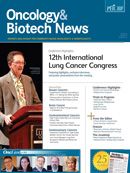Publication
Article
Treatment Guidelines for High-Grade Bladder Cancer Are Usually Ignored
Author(s):
Investigators have documented gross under-use of established recommendations for the management of high-grade noninvasive bladder cancer.

Karim Chamie, MD
Investigators have documented gross under-use of established recommendations for the management of high-grade noninvasive bladder cancer.
Karim Chamie, MD, with the University of California at Los Angeles, and colleagues reviewed practice patterns in 4545 patients aged ≥66 years who were diagnosed with poor or undifferentiated nonmuscle invasive (Ta, Tis, or T1) bladder cancer between 1992 and 2002, and who survived at least 2 years without undergoing definitive treatment.
Overall, only 1 patient was compliant with all quality-of-care measures proposed by major medical associations. In addition, compliance remained poor when the researchers used a liberal definition of compliance.
Chamie and associates said that guidelines intended to minimize the morbidity and mortality related to recurrence and progression of nonmuscle invasive bladder cancer were released by the National Comprehensive Cancer Network in 1998, the American Urological Association in 1999, and the European Association of Urology in 2002. The guidelines call for intravesical therapy and rigorous follow-up involving bladder cystoscopy and urine cytology every 3 months for the first 2 years after diagnosis.
Bladder cancer is the fifth most common malignancy, with nearly 71,000 new cases diagnosed in the United States in 2009. Patients need to be closely monitored because the disease has a high rate of progression and recurrence (50%-70%).
Also, because of the prolonged natural history of the disease coupled with the use of invasive followup and treatment strategies, treatment is more expensive for nonmuscle invasive bladder cancer than for any other malignancy. The cost per patient reportedly ranges from $96,000 to $187,000.
For their analysis, the researchers used the Surveillance, Epidemiology and End Results (SEER)-Medicare database, which links cancer registry information to a master file of patients enrolled in Medicare.
Even when they eased their definition of compliance to refer to at least 1 cystoscopy, 1 cytology, and a single instillation of intravesical Bacillus Calmette-Guérin (BCG) vaccine for any given patient during the first 2 years after diagnosis, the patient compliance rate was only 37%, and the provider compliance rate was only 58%.
Further analysis revealed that the physician was the key determinant of whether a patient was managed in accordance with clinical practice guidelines. Patient factors such as age, race, socioeconomic status, severity of comorbidities, and extent of their bladder cancer had minimal impact.
Chamie and colleagues said that their findings are in sync with other studies that have reported the under-use of effective care in bladder cancer patients.
The researchers emphasized that while the sample size was robust, it is possible that patient preferences for particular surveillance and treatment approaches may have confounded the finding of significant under-use. In addition, the results do not necessarily apply to patients who are aged ≥65 years or have other types of insurance coverage.
Finally, the authors said their study points out that the availability of guidelines is not enough to ensure good clinical practice. “Although bladder cancer may not be the weakest link in our healthcare system, it sheds light on the finding that clinically effective measures are not readily practiced through the mere publication of best-practice guidelines,” they wrote. It is hoped that their results will motivate policymakers to modify reimbursement policies or support qualityimprovement initiatives in order to boost the delivery of clinically effective care.
Chamie K, Saigal CS, Lai J, et al. Compliance with guidelines for patients with bladder cancer [published online ahead of print July 11, 2011]. Cancer. doi: 10.1002/ cncr.26198.










